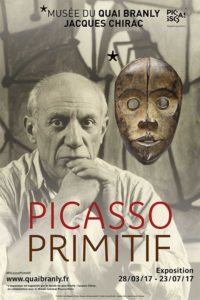 Picasso said he experienced a “revelation” while viewing African art at Paris’ Palais du Trocadéro ethnographic museum. “A smell of mould and neglect caught me by the throat. I was so depressed that I would have chosen to leave immediately. But I forced myself to stay, to examine these masks, all these objects that people had created with a sacred, magical purpose, to serve as intermediaries between them and the unknown, hostile forces surrounding them, attempting in that way to overcome their fears by giving them colour and form. And then I understood what painting really meant. It’s not an aesthetic process; it’s a form of magic that interposes itself between us and the hostile universe, a means of seizing power by imposing a form on our terrors as well as on our desires. The day I understood that, I had found my path.” His discovery that day of African art resulted in what became his “African” style (1906-1909) and his iconic “Les Demoiselles d’Avignon.”
Picasso said he experienced a “revelation” while viewing African art at Paris’ Palais du Trocadéro ethnographic museum. “A smell of mould and neglect caught me by the throat. I was so depressed that I would have chosen to leave immediately. But I forced myself to stay, to examine these masks, all these objects that people had created with a sacred, magical purpose, to serve as intermediaries between them and the unknown, hostile forces surrounding them, attempting in that way to overcome their fears by giving them colour and form. And then I understood what painting really meant. It’s not an aesthetic process; it’s a form of magic that interposes itself between us and the hostile universe, a means of seizing power by imposing a form on our terrors as well as on our desires. The day I understood that, I had found my path.” His discovery that day of African art resulted in what became his “African” style (1906-1909) and his iconic “Les Demoiselles d’Avignon.”
The “Picasso Primitif” exhibition at the Musée Branly (until July 23, 2017) traces the artist’s contacts with the so called “primitive” arts… what he saw, the collectors and dealers that he frequented along with links to his own art. In addition to the artist’s own paintings the exhibition includes documents, letters, photographs and African works collected by him.
“Picasso Primitif” covers the dates from PIcasso’s arrival in Paris in 1900 to 1974, one year after his death. When Picasso arrived to Paris in 1900 he encountered a cultural scene that was discovering African, Native American and Micronesian art. Around 1906 Picasso and other artists such as Henri Matisse and André Derain were intrigued and inspired by the power and simplicity of primitivism. At the same time an important posthumous retrospective of Paul Gauguin’s bold and colorful work was shaking up the Paris art world.
While the first part of the exhibition is didactic the second part is more visual drawing parallels between the works of Picasso and primitive artists through three themes: archetypes, metamorphosis and the Id. The genius of Picasso was that he didn’t just copy the work of primitive artists but brought the aesthetic into a modern context.
“Picasso Primitif” to July 23, 2017, Musée du Quai Branly Jacques Chirac

